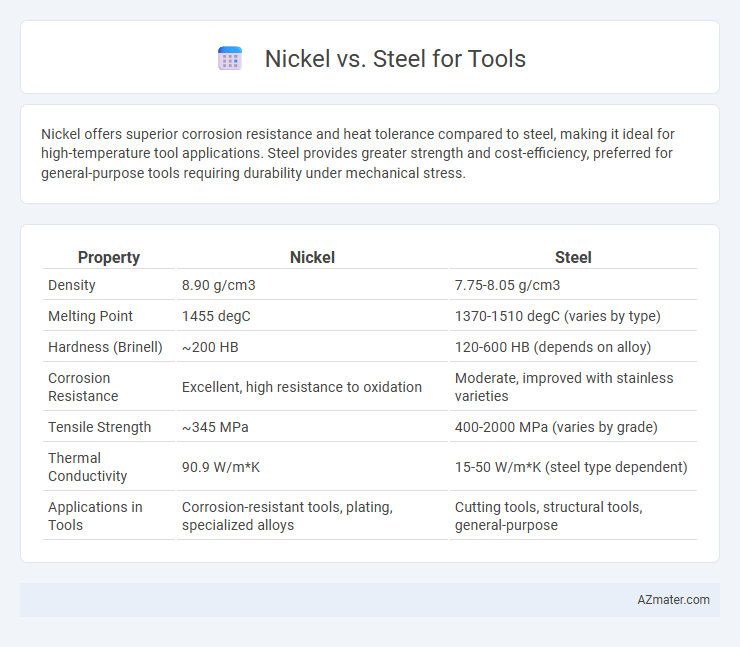Nickel offers superior corrosion resistance and heat tolerance compared to steel, making it ideal for high-temperature tool applications. Steel provides greater strength and cost-efficiency, preferred for general-purpose tools requiring durability under mechanical stress.
Table of Comparison
| Property | Nickel | Steel |
|---|---|---|
| Density | 8.90 g/cm3 | 7.75-8.05 g/cm3 |
| Melting Point | 1455 degC | 1370-1510 degC (varies by type) |
| Hardness (Brinell) | ~200 HB | 120-600 HB (depends on alloy) |
| Corrosion Resistance | Excellent, high resistance to oxidation | Moderate, improved with stainless varieties |
| Tensile Strength | ~345 MPa | 400-2000 MPa (varies by grade) |
| Thermal Conductivity | 90.9 W/m*K | 15-50 W/m*K (steel type dependent) |
| Applications in Tools | Corrosion-resistant tools, plating, specialized alloys | Cutting tools, structural tools, general-purpose |
Introduction: Nickel vs Steel in Toolmaking
Nickel and steel are essential materials in toolmaking, each offering distinct properties that influence performance and durability. Nickel excels in corrosion resistance and hardness, making it ideal for specialized tools exposed to harsh environments. Steel, particularly alloyed variants, provides superior strength, toughness, and cost-effectiveness, dominating widespread industrial applications.
Key Material Properties Compared
Nickel exhibits superior corrosion resistance and high-temperature strength compared to steel, making it ideal for tools exposed to harsh environments. Steel offers greater hardness and tensile strength, providing durability and impact resistance essential for heavy-duty tooling applications. The choice between nickel and steel tools depends on specific use cases, with nickel favored for chemical stability and steel preferred for mechanical robustness.
Strength and Durability Differences
Nickel alloys exhibit superior corrosion resistance and maintain strength at high temperatures, making them ideal for tools requiring long-term durability in harsh environments. Steel, particularly high-carbon or alloy steel, offers higher tensile strength and hardness, providing excellent wear resistance and the ability to withstand heavy mechanical stresses. While steel tools excel in toughness and impact resistance, nickel-based tools outperform in environments prone to oxidation and thermal degradation.
Corrosion Resistance: Which Performs Better?
Nickel outperforms steel in corrosion resistance due to its ability to form a stable, protective oxide layer that prevents rust and degradation, especially in harsh environments. Stainless steel, containing chromium, offers good corrosion resistance but is generally less effective than high-nickel alloys in highly acidic or saline conditions. For tools exposed to aggressive environments, nickel-based materials typically ensure longer durability and maintain structural integrity better than most standard steel variants.
Machinability and Manufacturing Ease
Nickel alloys offer superior corrosion resistance but exhibit lower machinability compared to most steel grades, often requiring specialized tooling and slower cutting speeds in manufacturing. Carbon and stainless steels provide better machinability with more predictable chip formation and surface finish, allowing for faster production rates and easier post-machining processes. Manufacturers often prefer steel for mass production due to its balance of strength, machinability, and cost-effectiveness, whereas nickel is reserved for high-performance tools demanding exceptional durability and heat resistance.
Cost Analysis: Nickel vs Steel Tools
Nickel tools typically incur higher initial costs than steel due to expensive raw materials and complex manufacturing processes, affecting overall budget allocation. Steel tools generally offer cost-effective production and widespread availability, leading to lower upfront expenses and easier maintenance. Evaluating total cost of ownership, including durability and corrosion resistance, nickel tools may provide long-term savings despite higher purchase prices.
Applications: Best Uses for Each Metal
Nickel excels in applications requiring high corrosion resistance and heat tolerance, making it ideal for chemical processing equipment, aerospace components, and medical instruments. Steel is preferred for tools demanding exceptional strength and durability, such as construction machinery, automotive parts, and heavy-duty hand tools. Selecting between nickel and steel depends on whether resistance to harsh environments or mechanical robustness is the priority for the tool's application.
Environmental Impact and Sustainability
Nickel offers superior corrosion resistance and durability compared to steel, resulting in longer tool lifespan and reduced waste generation. The extraction and refining processes for nickel generally have higher energy consumption and environmental impact than steel production, but advances in recycling nickel-based alloys mitigate these effects significantly. Steel tools, while often more energy-efficient to produce, tend to require more frequent replacement, leading to greater long-term resource use and environmental strain.
Maintenance and Longevity Considerations
Nickel alloys offer superior corrosion resistance and maintain structural integrity under high temperatures, reducing maintenance frequency compared to standard steel tools. Steel tools generally require regular lubrication and rust prevention treatments to avoid wear and degradation, impacting overall maintenance costs. The enhanced durability and resistance of nickel-based tools contribute to extended tool lifespan, making them cost-effective for long-term industrial applications.
Conclusion: Choosing the Right Material for Your Tools
Nickel alloys offer superior corrosion resistance and excellent hardness, making them ideal for tools used in harsh environments or requiring long-lasting sharpness. Steel, especially high-carbon and alloy steel variants, provides greater toughness and impact resistance, suitable for heavy-duty applications where durability is critical. Selecting the right material depends on balancing factors such as environmental exposure, required strength, and tool lifespan to ensure optimal performance and cost-effectiveness.

Infographic: Nickel vs Steel for Tool
 azmater.com
azmater.com